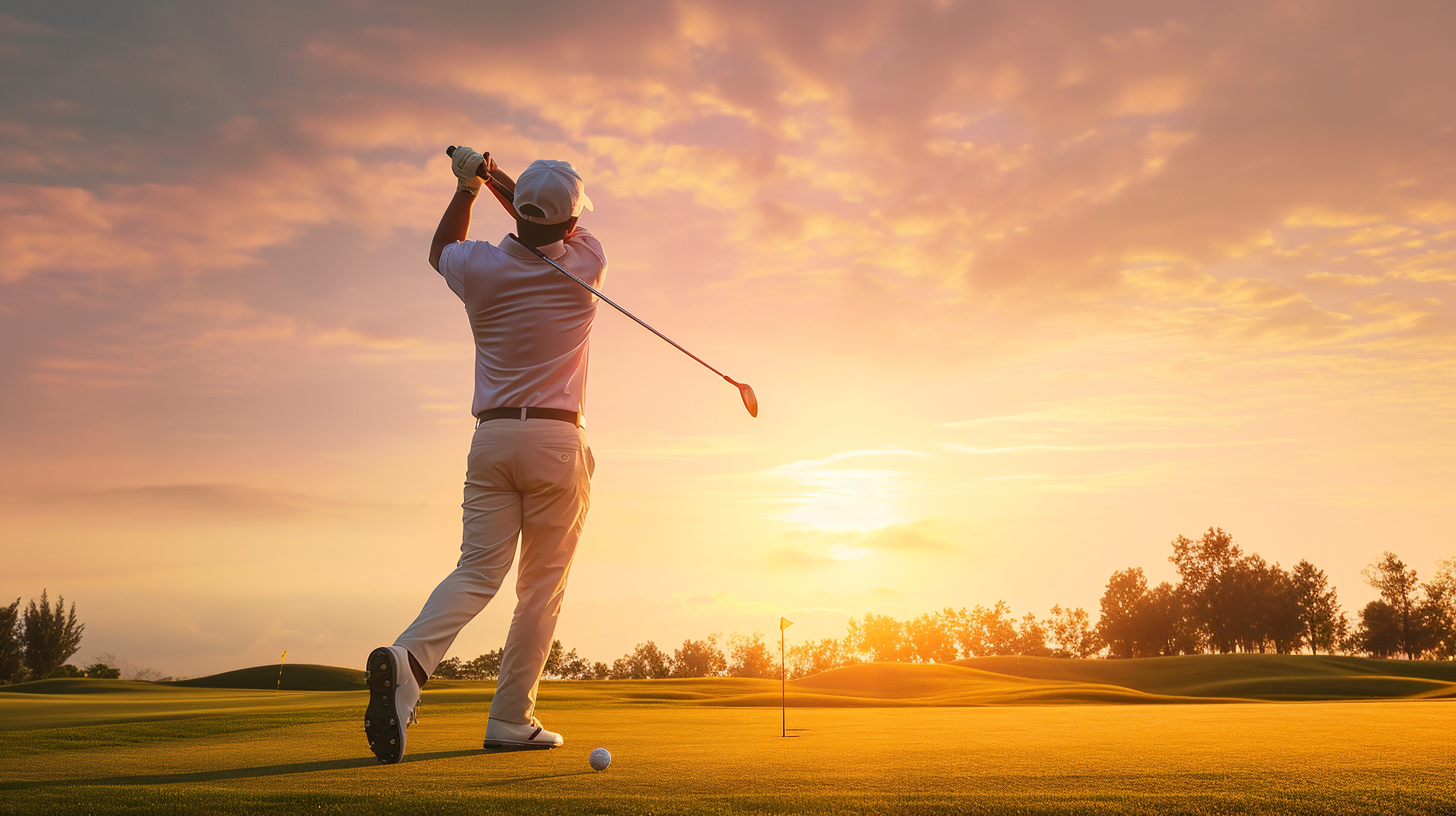Do you ever flap wildly at the ball or whiff shots off the tee, provoking laughs and knowing looks from playing partners?
Learning proper golf swing mechanics provides the remedy.
Mastering impact dynamics and maximizing the kinetic sequence in the golf swing determines driving accuracy and consistency.
Let’s break down the key elements of an effective golf swing step-by-step to ingrain solid mechanics.
1. Having Proper Stance And Grip
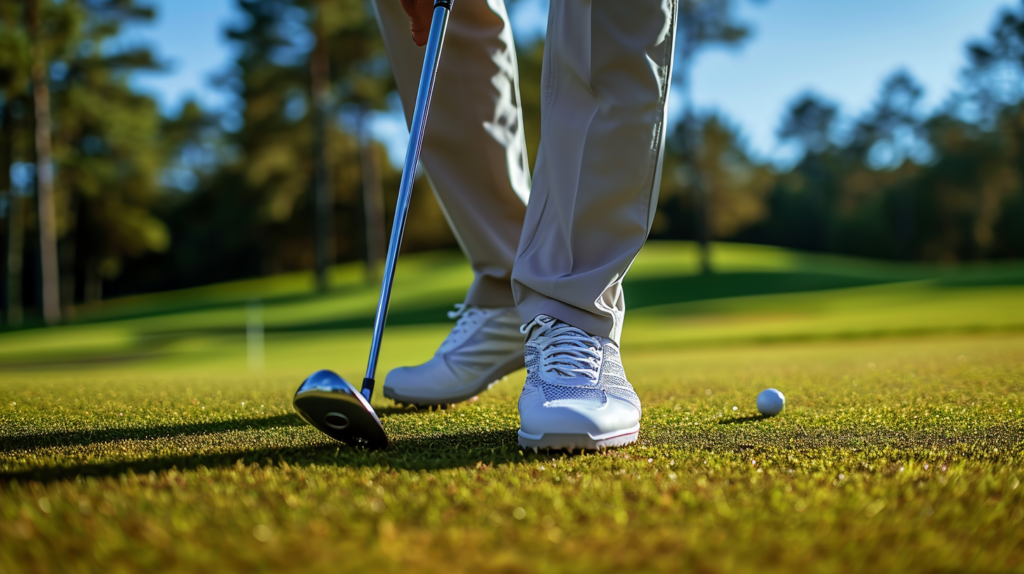
Having the proper stance and grip serves as the foundation for an effective golf swing, setting the stage for fluid mechanics through the rest of the sequence.
Without balance and stability from address position as well as optimal hand placement, even the most athletic motion struggles to find consistency. We will break down the key elements of both stance and grip in detail, focusing on fundamentals that facilitate solid impact with the golf ball.
When setting your stance, start by positioning feet about shoulder width apart to establish a solid base. Keeping feet too narrow or wide affects overall balance, making it harder to coil and shift weight properly without wobbling.
The exact footing depends partially on physical build and flexibility. Generally, aim for neutral foot flares with toes pointed out slightly rather than stark duck feet or pigeon-toed stances which feel less comfortable.
Proper athletic posture and spine angle get determined mainly by knee and hip angles. Set knees in a slightly flexed position, avoiding locked or hyper-extended legs which reduce mobility and ability to load and unload weight and power.
Hips should align over the mid-foot area rather than jutting forwards or backwards. This centers overall gravity for optimal control. The combination of knee flex and hip hinge creates the desired spine tilt.
Find an angle that feels stable and balanced while allowing the arms to hang comfortably off the shoulders down the club.
Up top, keep your chin up and eyes focused on the golf ball or in front of its target line path. This facilitates proper visualization of your swing path and ball flight result throughout the entire motion, helping adjust and correct where required.
Any deviation left or right loses sight of the central swing sequence and target area. Looking down drops the head angle and throws off standard posture. During full swings especially, keep eyes and head up.
Grip the club by first setting the handle into the fingers and palm of the lead hand (top hand for righties). How this hand connects to the club greatly influences face angle and overall control at impact.
Avoid gripping too far down into the palms or simply holding onto the club tightly in a white-knuckle death grip. Instead, hold it lightly but securely in the fingers which provide more sensitive manipulation of the club head.
Eliminating tension in the hands and forearms increases wrist hinge and tempo control as well. Place the handle diagonally across the pads of the fingers towards the base of the palm, with pressure points on the last three fingers and heel pad.
The lead thumb should rest gently down the top side of the grip without squeezing.
Add the trail hand (bottom right hand for righties) by overlapping, interlocking or placing side by side aligned on top of the lead. Experiment to find which style feels most comfortable and facilitates consistent grip pressure throughout the swing motion.
The trail thumb typically rests just to the side along the index finger of the lead hand. Avoid letting hands separate or detach through impact as this diminishes control of the club face angle.
Whichever style you choose, both hands should connect as one unit firmly controlling the golf club. Check grip alignment by addressing a straight target line while holding the club out in front of you parallel to the ground at belt height.
The club face should point directly up or perpendicular to swing direction along target line. Adjust hand rotation and pressure as required so club face sets neutral here. This establishes proper orientation for squaring the face to the ball at impact.
2. Setting Up Proper Backswing Fundamentals
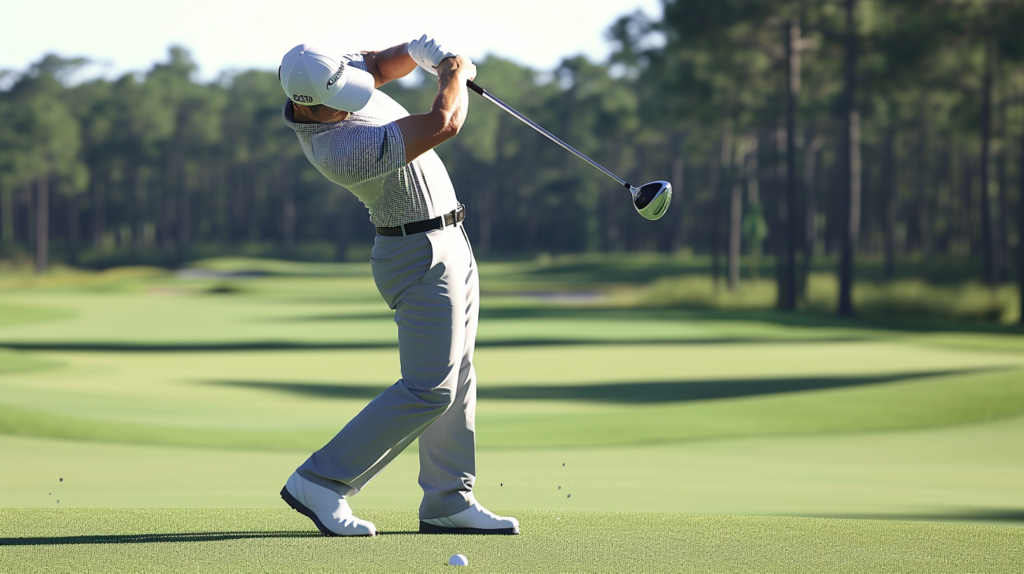
With solid footwork established along target line and hands securely gripping the golf club aligned to swing path, we can now build an effective backswing.
This rotation away from the ball loads potential power into the core, hips and shoulders, setting up kinetics for proper release and sequence down into impact. Dialing in key positions and postures here facilitates optimal delivery.
Initiate by turning the chest clockwise (for righties) while rotating shoulders around the spine angle, keeping that posture established at setup. Hand and arm movements follow automatically from core torso rotation rather than overly lifting with hands first.
Excessive early wrist cock also throw club sequence and contact point out of whack. Let the bigger muscles initiate takeaway while arms and club respond. Avoid swaying weight backwards or laterally and instead rotate evenly around centered balance over the balls of both feet.
This also keeps head still over start position through the initial phase of backswing, promoting consistency shot to shot.
As wrists hinge and torso rotates further, lift both arms keeping lead arm connected to chest. The triangle created naturally here between arms and shoulders establishes desired swing plane angle.
Allow trail elbow to fold while lead arm stays relatively straight, hinging at the shoulder socket. Power accumulates from hips and core winding against resistance of torso and arms coiling in sequence.
Time these movements accelerating at a steady tempo while maintaining posture and integrating the kinematic sequence from ground through hips, shoulders and arms. Find optimal endpoint for your flexibility somewhere between parallel and perpendicular to ground.
This completes ideal loading of your personal “bow and arrow” setup.
Most golfers get into trouble on the backswing letting certain body parts move too independently, affecting sequence timing and often overswinging the club beyond parallel. Avoid straightening knees or excessive leaning of upper torso as this saps rotational power and balance.
Keep turning shoulders and chest until hands approach waist high with lead arm parallel and trail elbow pointing down. Hips should turn about 45 degrees with lead hip internally rotated in its socket.
Maintain relaxed grip pressure and tempo here, fully loaded into the backswing launch position. This sequences properly into initiating the forward swing for solid ball striking.
3. Executing A Fluid Forward Swing Sequence
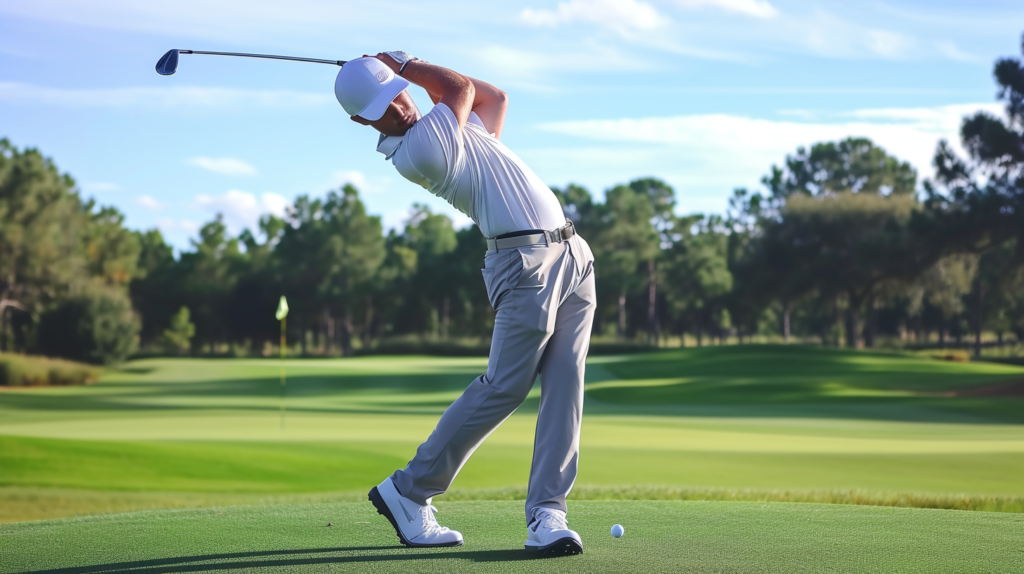
With knees and hips coiled 45 degrees and shoulders turned 90 degrees fully loaded, the transition to forward swing unwinds from the ground up. Maintaining spine posture and balance, begin dropping shifting pressure to the lead side by clearing lead hip back towards the target.
This lateral motion creates space to swing arms and club down from the inside. Allow shifted weight and momentum to shallow the downswing plane automatically.
As lead hip slides left, rotate to face the target and pull shoulders into impact zone by allowing the knees and arms to follow in sequence. Rather than overly releasing with hands and arms from the top, maintain the backswing triangle angle as long as possible from hips to shoulders to hands.
Firing hands first from the top throws club onto an outside path, inducing slices and inconsistent strikes. Instead, keep elbows connected to core rotation into the hitting area.
Hips, torso and arms should move in one synchronized motion through impact, releasing club head lag only at the last moment for maximum speed.
This sequenced uncoiling into a braced lead leg allows your body to supply most of the speed rather than relying on hands and arms alone. Driving the lead hip left pulls arms and club into delivery position automatically.
Coordinate hip and shoulder rotation through impact zone for optimal release timing. Avoid breakdowns like swaying, lifting or sliding weight backwards.
Maintaining sound connection from ground through hips, core and arms concentrates forces behind the golf ball most efficiently at contact.
The feeling at impact should compress the ball against the turf before sweeping along and taking a slight divot afterwards. Strike consistently an inch or so behind the ball by brushing the grass lightly first at impact.
This contacts the ball as club head travels upwards along arc for ideal low point compression with irons and fairway woods especially. Driver arcs vary due to lie angle and technique.
Focus on keeping the head still and spine angle consistent from address into impact to regulate strike point consistency.
Align club face angle squarely to target line at impact so the ball launches directly towards your aim point with minimal curve. Coordinating the correct swing path direction sets up initial starting trajectory while adjusting club face angle through impact introduces shot shaping like draws or fades.
An open club face relative to path curves shot right as the ball spins sideways more, while closed faces draw left via opposite spin axis tilt. Always focus fundamentals on squaring the face first however, then work sidespin curve effects shot by shot based on that centered strike.
4. Extending The Swing Through A Balanced Finish
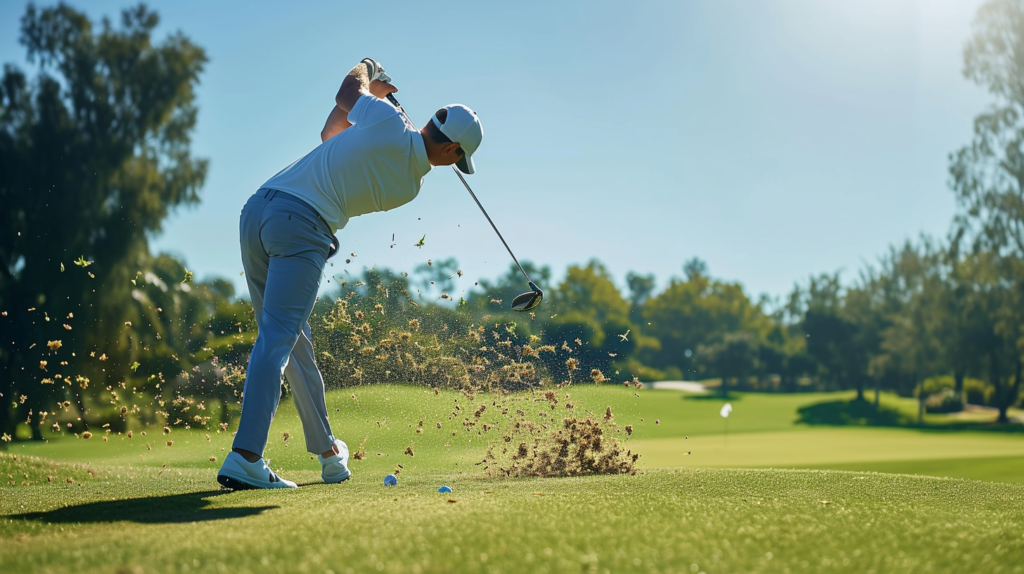
With legs driving downwards and hips clearing out of the way into impact zone, the golf swing finishes unwinding upwards as arms fully extend releasing club head speed behind the ball. Avoid prematurely cutting off the motion as this decelerates club head before optimal contact.
Similarly, flipping hands over at the ball casts angle of attack too steep. Fully rotate posting up on the lead side to allow arms to continue swinging forwards automatically through contact extending towards target.
This follow through whipping action concentrates all accumulated kinetic sequence directly into the back of the golf ball right at compression point.
Ideally, the finish position stabilizes in a fully rotated impact pose around the lead leg anchored into the turf. Hips open facing target square on as shoulder rotation pulls the trail side all the face around as well.
Since most speed and power derived from the lower body, weight remains driving forward through the lead hip and centered over lead knee. Avoid lifting the lead heel up or jumping backwards, instead fully committing weight left.
This keeps body behind ball longer, promoting consistently solid impact and maximum energy transfer into each shot.
Upper body finishes balanced in an athletic upright posture, arms extended towards target and club pointing down extended target line. This flows as the natural concluding motion after hips and shoulders continue rotating past impact zone through to facing front.
Extending the swing to a balanced finish enables full release rather than short cutting follow through just to get the ball airborne quicker. Rushing collapse backwards loses control of face angles and strike consistency.
Patiently post through each swing staying centered asserts optimal fundamentals for fluid strike after strike.
5. Mastering Consistent Ball Strike At Impact
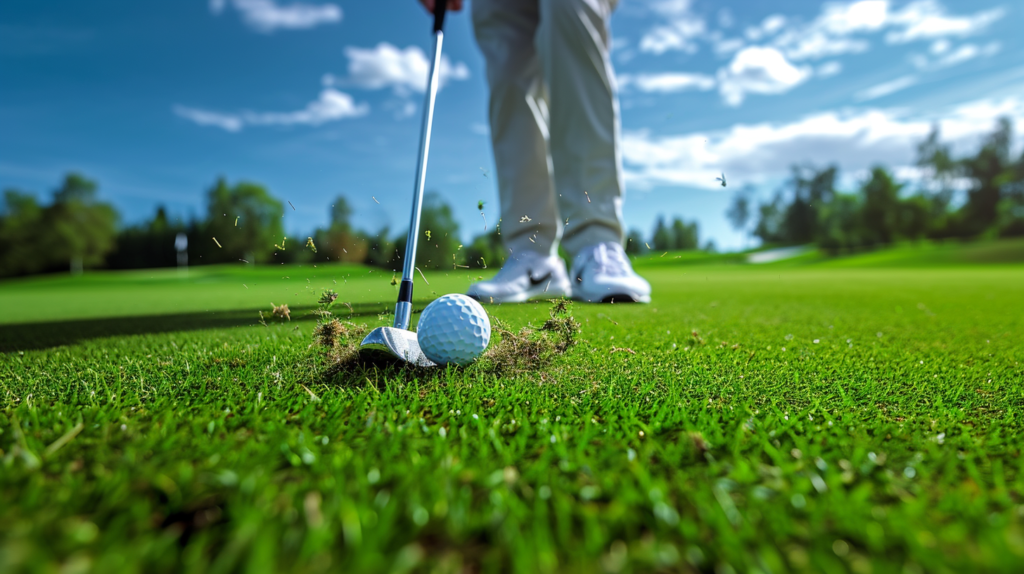
The sole purposes of integrating the entire kinetic sequence in the golf swing aim to reliably strike the ball solidly in the center of the club face with efficient impact dynamics launching the ball towards your target. This section examines key characteristics of sound ball striking, applying the fundamentals built thus far.
Learn to analyze feel, flight and strike results after each shot to self-correct through feedback.
At impact, the bottom edge of your swing arc should sweep lightly along the grass an inch or so behind the ball so that club head contacts turf fractionally after sweeping underneath the ball. This produces ideal angle of attack with irons especially to impart forward spin and compress ball between club face and ground for that classic impact “pop”.
Thick chunks of turf and divots after contact signal overly steep attacks hitting down too much from outside. Conversely shots thin out low rocketing from the crown of the club often occur when swing bottoms out prematurely.
Regulate consistent ball strike by keeping head still with spine angle centered through impact. Hands lead club head release just slightly with smooth acceleration rather than overly releasing early with angle attacking too steep.
This consistent motion brushing slightly up under each ball regulates low point regardless of lie. Crisp shots result from keeping wrists hinged a fraction longer holding lag just before hands uncock through impact.
Compressing the ball first against fairway or turf produces a different sound and satisfying flight. Learn to self-diagnose by paying attention to visual, audio and sensory feedback after every shot.
The club face angle as it contacts ball largely determines initial launch direction as shots want to start perpendicular away from face center. Thus aligning club face squarely to target line enables straight shots towards your aim point.
Master setup fundamentals first by ensuring grip aligns face properly at address. Then ingrain proper backswing, transition and release motions to return it there at impact.
Curve or shape shots draw left or fade right by closing or opening face angles in relation to target line just prior to contact. Learn to regulate face flow through impact for desired shot flights rather than randomly hoping to make good contact.
Swing path arc similarly influences ball curvature by establishing sidespin axis tilt relative to face angle. Inside-out paths closing from right of target to left through impact induce right to left ball flights on properly aligned faces.
Outside-in arcs promote opposite left curve. Global swing motions largely govern these effects. So again prioritize squaring the face solidly to desired target line, then introduce draws or fades subtly tweaking path arcs.
Some players naturally swing more in-to-out or out-to-in requiring alignment accommodations. Careful analysis of both club face control and swing direction pays dividends optimizing impact dynamics for accurate centered ball striking.
Conclusion
An effective golf swing synchronizes the entire body in one fluid sequence originating from the turf upwards. Proper setup establishes balanced athletic posture alignment promoting optimal swing motions to follow.
Backswing coiling then loads power potential into the hips and core musculature by rotating shoulders and arms up to fully loaded launch positions. Weight transfers and untwists forwards from the legs, hips and core, pulling arms and club back into impact delivering maximal club head speed precisely into the back of the ball.
Extending through to a balanced finish completes free flowing kinetics for pure ball striking. Learn to apply key fundamentals from address through the entire motion by ingraining core positions. Building proper swing DNA pays dividends shot after shot out on course.
